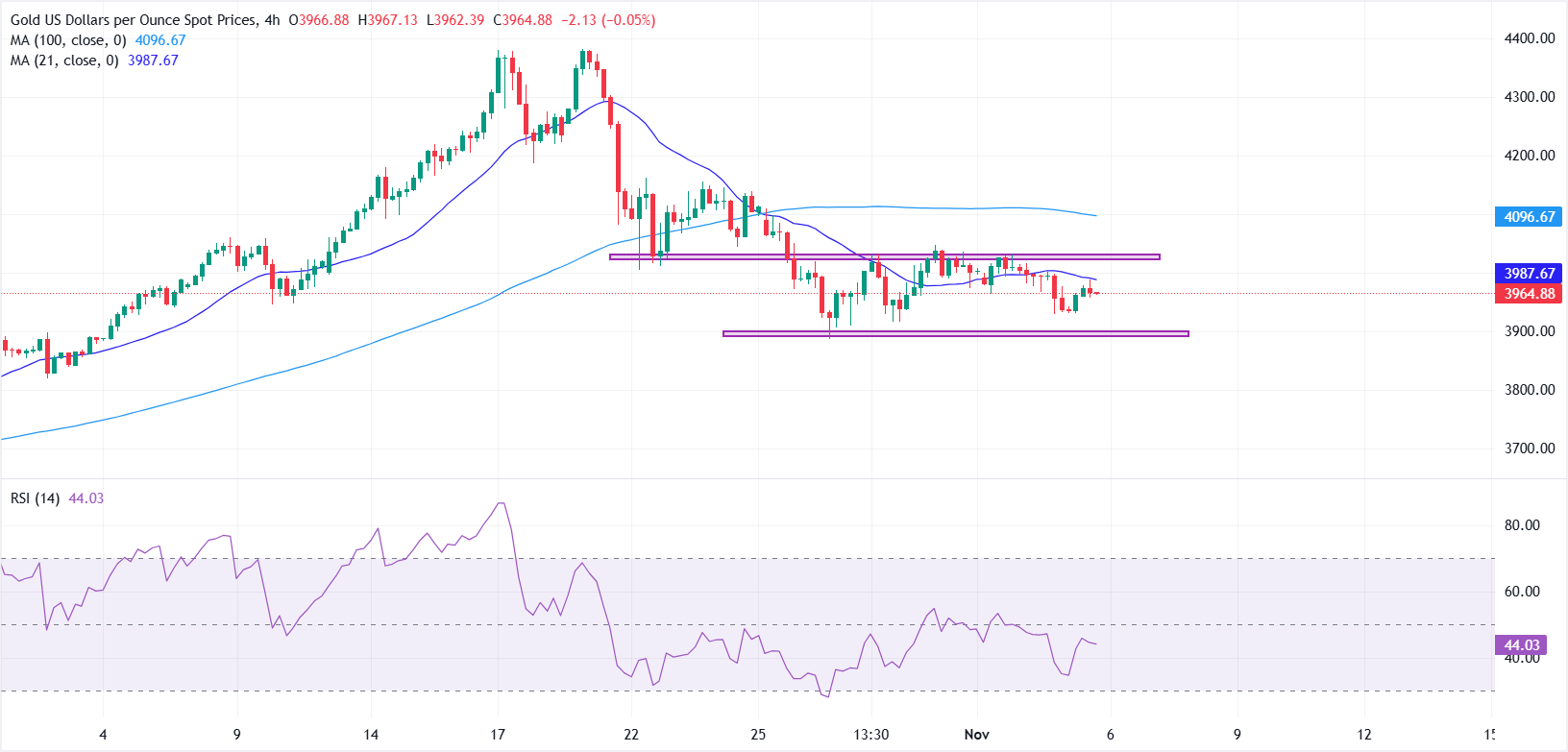Gold steadies ahead of ADP and ISM reports; US Dollar strength caps upside
- Gold holds firm as risk-off sentiment supports safe-haven demand amid global equity weakness.
- Investors await ADP and ISM Services PMI for cues on the labor market and Fed monetary policy outlook.
- Technically, Gold’s short-term bias remains slightly bearish, with XAU/USD trading below the 21-period SMA near $3,990.
Gold (XAU/USD) holds steady within familiar ranges on Wednesday as a mild risk-off tone across global markets underpins demand for the safe-haven metal. At the time of writing, XAU/USD is trading around $3,965, recovering modestly from Tuesday’s low of $3,928.
The risk-off sentiment follows a broad sell-off in global equities, led by weakness in US tech and AI-related stocks. Concerns about stretched valuations and warnings from Wall Street executives of a potential correction sparked the downturn, which rippled through Asian and European markets. Meanwhile, ongoing uncertainty surrounding the prolonged United States (US) government shutdown added to the cautious tone.
However, Gold’s recovery lacks strong follow-through buying as the resilient U.S. Dollar (USD) continues to cap upside attempts. Investors now await the ADP Employment Change and ISM Services PMI reports due later in the day, which could provide fresh trading impetus.
Market movers: ADP, ISM PMI eyed as US tariff ruling looms
- The US Dollar Index (DXY), which gauges the Greenback’s strength against six major peers, is consolidating near recent three-month highs, trading around 100.17 as traders remain cautious ahead of key US economic data releases.
- US President Donald Trump signed two executive orders on Tuesday aimed at easing trade tensions with China, following a recent meeting and trade agreement with Chinese President Xi Jinping. Effective November 10, the tariff on fentanyl-linked imports from China will be reduced from 20% to 10%, while the reciprocal tariff rate on Chinese goods will remain at 10% for another year, extending a truce that lowered the original rate from 34%. Beijing responded by temporarily lifting some retaliatory duties on US agricultural and industrial products.
- The legality of the Trump administration’s tariffs is back in the spotlight as the US Supreme Court prepares to hear arguments later on Wednesday over whether the use of emergency powers to impose broad import duties was lawful. Two lower courts have already ruled the tariffs illegal, and the outcome could shape the future scope of presidential authority over trade policy.
- The US government shutdown entered its thirty-sixth day on Wednesday, marking the longest in history. The funding deadlock continues to delay key economic data releases and fuel worries about its growing impact on the broader economy.
- The monetary policy outlook remains clouded after last week’s 25-basis-point (bps) rate cut, as Federal Reserve (Fed) Chair Jerome Powell signaled that further easing this year is “not a foregone conclusion.” Still, diverging opinions among Fed officials on inflation and labor market conditions have left markets uncertain over the prospect of another rate cut in December.
- According to the CME FedWatch Tool, markets now price a 71% chance of a December rate cut, down sharply from 94% before Powell’s remarks. With official economic data delayed by the ongoing shutdown, the ADP and ISM Services PMI figures could prove pivotal in shaping near-term Fed expectations.
Technical analysis: Bearish bias holds below 21-SMA, RSI signals weak momentum

Gold remains trapped in a narrow range between $4,050 and $3,900 on the 4-hour chart, reflecting indecision among traders. The short-term bias leans slightly bearish as the metal continues to trade below its 21-period Simple Moving Average (SMA) near $3,990, which caps immediate upside attempts. A stronger recovery would need a break above the former support-turned-resistance zone at $4,020-$4,050 to attract fresh buying interest.
On the downside, repeated buying interest near the $3,900 area continues to offer a solid floor for now. A clear break below this level could open the door toward deeper losses.
The Relative Strength Index (RSI) holds around 44, suggesting subdued momentum and keeping Gold vulnerable to further range-bound trading in the near term.
Economic Indicator
ADP Employment Change
The ADP Employment Change is a gauge of employment in the private sector released by the largest payroll processor in the US, Automatic Data Processing Inc. It measures the change in the number of people privately employed in the US. Generally speaking, a rise in the indicator has positive implications for consumer spending and is stimulative of economic growth. So a high reading is traditionally seen as bullish for the US Dollar (USD), while a low reading is seen as bearish.
Read more.Next release: Wed Nov 05, 2025 13:15
Frequency: Monthly
Consensus: 25K
Previous: -32K
Source: ADP Research Institute
Traders often consider employment figures from ADP, America’s largest payrolls provider, report as the harbinger of the Bureau of Labor Statistics release on Nonfarm Payrolls (usually published two days later), because of the correlation between the two. The overlaying of both series is quite high, but on individual months, the discrepancy can be substantial. Another reason FX traders follow this report is the same as with the NFP – a persistent vigorous growth in employment figures increases inflationary pressures, and with it, the likelihood that the Fed will raise interest rates. Actual figures beating consensus tend to be USD bullish.

